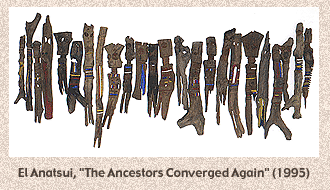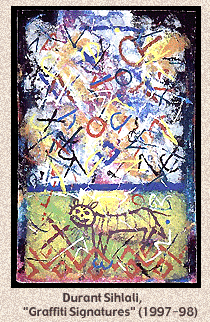The 'newness' of migrant or minority discourse has to be discovered in medias res: a newness that is not part of the 'progressivist' division between past and present, or the archaic and the modern; nor is it a 'newness' that can be contained in the mimesis of 'original and copy.'
[. . .] I am more engaged with the 'foreign' element that reveals the interstitial [. . .] that has to be engaged in creating the conditions through which 'newness enters the world.'--Homi K. Bhabha, "How Newness Enters the World," 227
- Material culture forms its own discourses, discourses that change radically when objects are translated, fragmented, and relocated. Frequently, such resituation erases history as well as context. In the case of African art, Western collectors and museums often equate objects' antiquity with authenticity and value. Yet those objects assigned the greatest value are granted the 'timelessness' of high art, in contradistinction to the 'static past' of the ethnographic artifact, on the one hand, and to the 'transient present' of tourist art, on the other.[1] Certainly, recent trends in curatorship (showing videotapes of objects in use, supplementing academic explanations with those of 'native informants,' attributing some traditional masterpieces to individual artists) attempt to reconstruct functional and cultural contexts for African artworks. Nonetheless, these trends also form a self-reflexive critique. They open an 'interstitial' space of anxiety, exposing the uneasy negotiations between colonial forms of connoisseurship and art collecting -- implicated as they are in imperial exploitation and in the dehistoricization of the 'primitive' central to ethnography -- and the postcolonial museum.
- "Encounters with the Contemporary" at the National Museum of African Art (NMAfA) confronts this anxiety by showcasing the very qualities that bedevil orthodox approaches to African Art History: newness (these are late twentieth-century and early twenty-first century works), politico-historical engagement (especially but not exclusively evident in the South African art on display),
authorial agency (the modest exhibit brochure and the wall notes concentrate on artists' biographies and statements of intent), and 'mechanical reproduction' (the inclusion of fine-art prints and photomontage). [2] The impetus for this exhibit seems to be a desire to detach the NMAfA from its ethnographic and ethnoaesthetic roots. As the museum's web "mission statement" maintains, the show "represents a new beginning [. . . that] will usher in an era in which contemporary African art acquires a greater permanence in our galleries and in the eyes of our public" ("Introduction" 1).
- Nonetheless, a certain impermanence hovers over the exhibit. This impression is due to the embedded rotating display (some of the works are on view for only four months, while most are shown for the entire year), to the uninspired use of space and light (for example, one cannot see large canvases properly), and to the lack of discernable narrative organization -- chronological, regional, thematic, formal, or otherwise. Despite the museum's announced attention to socio-political contexts and to the complexities of transnational artistic production, the illusion of transparency remains. So do unaddressed issues that could have been engaged if the NMAfA had been able to mount this show as a major exhibition, complete with an accompanying catalogue raisonné.[3] Artworks may speak for themselves, but a more comprehensive scholarly treatment and a situated interrogation of its own attitude toward contemporary African art would benefit both the museum and its visitors.
- I'm probably just cranky; my long-standing interest in the field has centered on traditional sculpture, and I would welcome more information about artwork currently produced in Africa and the present-generation African diaspora. So let me change perspective and note that "Encountering the Contemporary" raises a number of fascinating concerns. Among these are:
--the relation of African modernism to European modernism, and the companion issue of reclaiming appropriated forms;
--the definition of 'African Art': most of the show's artists have studied and worked in Europe and the U.S., some now live abroad, and a few were born outside Africa . . . not to mention whether the totalizing label of 'African Art' itself attends to the specific, yet often mixed cultural contexts in which artists work . . . not to mention what it means to have a 'National Museum of African Art' in the United States, and whether inclusion of contemporary and diasporic work alters that meaning;[4]
--the question of authenticity revisited:
is contemporary African art 'authentic' when it refers to localized origins -- that is, when it incorporates traditional forms and motifs (e.g. the hand-coiled ceramics of the Kenyan potter Magdalene Odundo or the wood sculptures of the Ghanian artist El Anatsui),--the role of gender on artistic production and marketability, as only four of the thirty-two artists represented here are women;
or is value inscribed in localized political content (again, works by South African artists come to mind, but one should not overlook politicized art from other areas, such as the Nigerian printmaker Bruce Onabrakpeya's etchings),
or in international reputation (as with the sculptor Sokari Douglas Camp, whose work was the first contemporary art purchased by the NMAfA and who has been showcased in individual and group shows in Europe and Asia as well as in the U.S.),
or in previously recognized schools, institutional or formal or both (as is the case of the well-known Nsukka school artist and scholar, Chike C. Aniakor)?
--the forces that drive today's museum acquisitions, as almost all the works exhibited were purchased in the 1990s (the two pieces acquired in the 1980s were gifts and both are recognizably modernist) . . . bought in the year 2000 are two powerful mixed-media works by Berni Searle, a South African woman artist, and three more pieces (two of which also address political issues, and one by Gerard Sekoto, a pioneer of African modernism) that are not yet on display;
--the effect of colonialism and its legacies (including language hegemonies) on evaluation and acquisition of African art (most of the exhibition's artists are from nations previously under English imperial rule: thirteen from South Africa, five from Nigeria, two each from Ghana and the Sudan).[5]

- Perhaps "Encounters with the Contemporary" should be taken at face value, as an initial step toward freeing museum-housed African art from its ahistorical fetters. Certainly, the exhibit's emphasis on what Claude Lévi-Strauss called the 'historifiable' -- as opposed to the 'ethnographiable' -- suggests an ideological stance behind this collection. Many of the works are specifically scriptive: exquisite drawings by Osman Waqialla and Nja Mahdaoui invoke Islamic calligraphy traditions; Alexander "Skunder" Boghossian's lovely "Spring Scrolls" recalls Coptic writing and iconography; Durant Sihlali's "Graffiti Signatures" -- an exuberant treatment of transgressive urban interventions -- makes a post-Baudrillardian move into the third space of South African cityscapes; the aforementioned Berni Searle's "Stain" combines written text and photography to interrogate the effects of state apparatuses on individual citizens.
- Other works are scriptive in less obvious ways. Gavin Jantzes's monumental untitled canvas represents a Khoisan creation myth, and its strong figures outlined against a dark, star-studded background cite the painted and incised rock walls that evidence the sophisticated visual vocabulary belonging to 'prehistoric' South African peoples. Godfried Donor's "Madonna and Child," even as it avoids the elephant dung so outrageous to xenoscopic Londoners and New Yorkers, employs a hybrid iconographic grammar to suggest the vexed convergences of Western and African religiosity and gender stereotyping.
One of my favorite pieces in this exhibit, Willie Bester's "The Notorious Green Car," uses color, objects, and spatial arrangement to script a version of apartheid terror, producing a readable narrative of state oppression. In a related mini-exhibit, the (Armenian-born) Egyptian artist Chant Avedissian's stenciled and painted textiles interfuse hieroglyphic and calligraphic histories with the infinitely reproduceable messages of p[r]op art.
- The Smithsonian's changing negotiations between (high) art and (ethnographic) artifact, between the old and the new (an entirely different opposition), are also in evidence elsewhere in the museum complex. At the Museum of Natural History, the hoary cultural dioramas -- complete with 'native mannikins' that bear disturbing similarities to the zoological taxidermy and dinosaur bone collections deposited in adjacent halls -- have been updated via a new exhibit, "Africa Speaks," which includes recordings, photos, contemporary objects (e.g. a fantasy coffin from Ghana), and diasporically inclined installations (e.g. an Afro-Caribbean botanica interior). But this museum's spaces forge a mobile metonym: spatial contiguity creates slippages of meaning among collections of animals, objects, and 'primitive people,' making each exhibit stand for the whole complex of colonialist assumptions driving early 20th-century museumology. The location of "Africa Speaks" (it adjoins the African/Asian/Oceanic cultural dioramas) situates it squarely within this complex; indeed, it can be read as authorizing rather than contesting colonial ethnography.
- The "When the Spirit Moves" exhibit (until June 1, 2001), which illustrates African roots of African American dance styles, should have escaped this sort of metonymic contamination, as it is installed in the relatively empty spaces of the Smithsonian's Arts and Industries building. Nonetheless, the first display a viewer encounters -- two life-sized figures, one dressed in a Dogon ritual mask and the other in American hip-hop clothes -- immediately recalls cultural dioramas, as do the two-dimensional representations of juke joints and jazz clubs. The same building currently features "Santos:
Substance & Soul/Sustancía Y Alma" (closing at the end of March, 2001) which happily combines antique and contemporary religious art from South, Central, and North America. The only cultural dioramas in evidence are those carved into the bultos and retablos on display.
- More aggressive juxtaposition of the modern and the traditional occurs at the Sackler Gallery of Asian Art (across from the NMAfA). In the foyer is a small but compelling installation of contemporary Indian painting and traditional (but recently produced) Indian folk art -- large terra cotta votive figures from Tamil Nadu. The guiding principle of this installation comes from the artist/critic/teacher J. Swaminathan (1929-94), who found unacceptable any concept of modernism that excludes folk or tribal art. With this precept in mind, viewers are more apt to see the sleek, notational lines of traditional sculptures and to detect traditional elements in otherwise avant-garde canvases. An additional treat for those wrestling with integrating (or differentiating) the old and the new awaits in the downstairs galleries. "Changing Tastes: Indian Painting of the 18th to the 20th Centuries" presents an impressive array of works, from Rajput court paintings to British aquatints to hybrid 'company style' canvases to Gujarati portraits mimicking Western photographic conventions. Around a corner, unexpected, one finds a large canvas, combining color-field sensibility with elements from the Devanagari alphabet and visual echoes from Tantric meditation diagrams, by J. Swaminathan.
- Overall, the Smithsonian museums enter this millennium with a view to the interstitial, particularly to the relationships between the old (always already museum-worthy) and the new (risky business). My caveats notwithstanding, I hope residents or visitors to the Washington area will attend these exhibits. Viewing "Encounters with the Contemporary" is especially important, as strong attendance figures will bolster the NMAfA's ability to pursue and improve its commitment to African art of the historical present. The museum's budget constraints account (at least in part) for the tepidness of this exhibition's installation, promotion, and scholarly/educational apparatus. The works on display deserve more, as do comprehensive African Art studies.